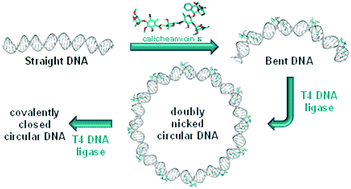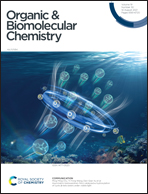Structural and mechanistic insight into DNA bending by antitumour calicheamicins†
Abstract
Among the class of enediyne antibiotics endowed with potent antitumour activities, the calicheamicin derivative known as ozogamicin is selectively targeted to several leukaemia cell types by means of tailor-made immunoconjugates. Binding of these drugs to the DNA minor groove in a sequence-specific fashion eventually causes double-stranded cleavage that results in cell death. Use of calicheamicin ε, an unreactive analogue of calicheamicin γ1I, has demonstrated that these structurally sophisticated molecules inflict bending on certain DNA oligonucleotides of defined sequence to the extent that they increase their circularization ratio upon ligation into multimers. By modelling and simulating several linear and circular DNA constructs containing high-affinity 5′-TCCT-3′ and low-affinity 5′-TTGT-3′ target sites in the presence and absence of calicheamicin ε, we have shed light into the structural distortions introduced by the drug upon binding to DNA. This new insight not only informs about the direction and magnitude of the DNA curvature but also provides a rationale for an improved understanding of the preferred structural and dynamic features associated with DNA target selection by calicheamicins.

- This article is part of the themed collections: Chemical Biology in OBC and Mechanistic, computational & physical organic chemistry in OBC


 Please wait while we load your content...
Please wait while we load your content...